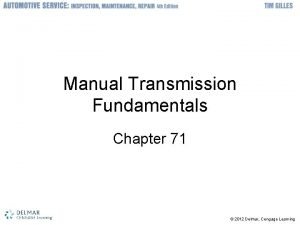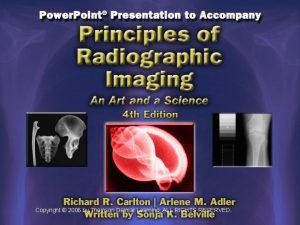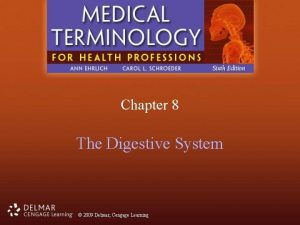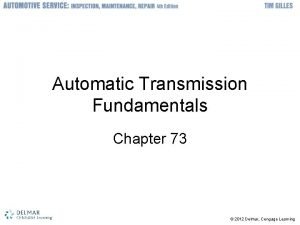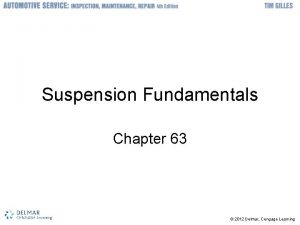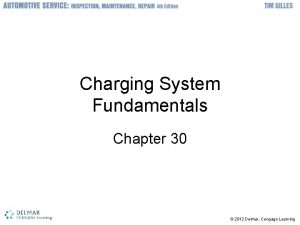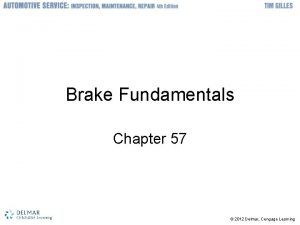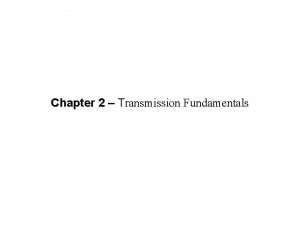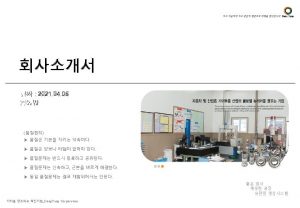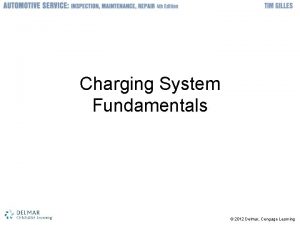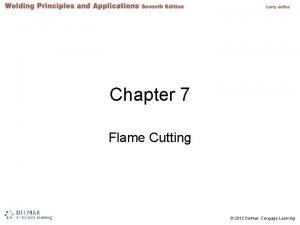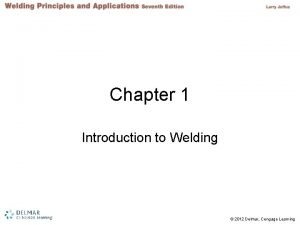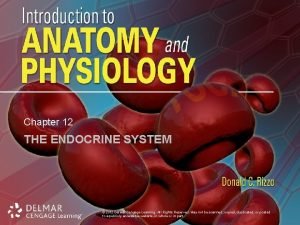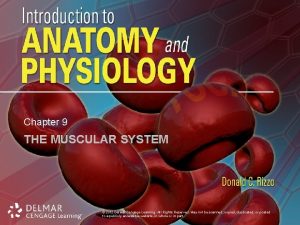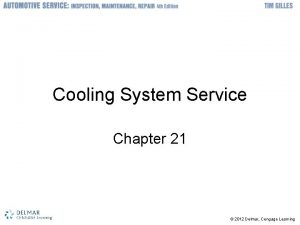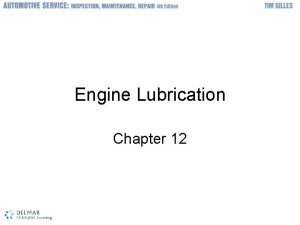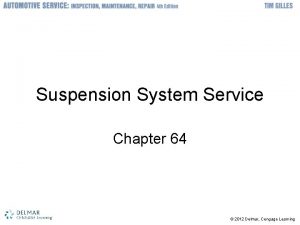Manual Transmission Fundamentals Chapter 71 2012 Delmar Cengage




















- Slides: 20

Manual Transmission Fundamentals Chapter 71 © 2012 Delmar, Cengage Learning

Objectives • Describe the relationship between gears and torque • Understand the basic types of gears • Calculate gear ratios • Trace the power flow through three-, four-, and five-speed transmissions • Name all of the transmission parts © 2012 Delmar, Cengage Learning

Introduction • Manual transmission • Used with clutch – Shifted between gears manually • Transmission – Used in rear-wheel-drive cars • Transaxle – Used in front-wheel-drive cars © 2012 Delmar, Cengage Learning

Purpose of a Transmission • Provide a means of changing torque to fit engine operating requirements • Low gear – Crankshaft turns three times to one turn of transmission output shaft – Small gear drives a larger gear • Gears provide leverage © 2012 Delmar, Cengage Learning

Using Gears to Increase Torque and Gear Ratio • Driving gear smaller than driven gear – Output speed decreases – Output torque increases • Gear radius – Distance from center of a gear to its outside edge • Gear ratio – Number of teeth on driven gear divided by number of teeth on driving gear © 2012 Delmar, Cengage Learning

Transmission Gear Ranges and Overdrive • Transmissions in cars and light trucks – Three-six forward gear ranges • Overdrive – Opposite of gear reduction • Output shaft turns faster than input shaft – Ratio a step beyond 1: 1 ratio of high gear • Planetary gears – Automatic transmission with lock-up torque converter © 2012 Delmar, Cengage Learning

Final Drive Ratio and Gear Types and Operation • Final drive ratio – Ratio between transmission output shaft and differential ring gear • Gear tooth shape – Allows teeth to roll into and out of mesh with minimum friction • Contact pattern: where teeth of two gears meet • Pitch diameter: diameter of meshed gear – Manual transmission uses two types of gear • Spur and helical gear © 2012 Delmar, Cengage Learning

Spur Gears • Simple gears with straight-cut teeth – One tooth carrying the load at time • No end thrust • Transmission will not attempt to pop out of gear • Backlash – Clearance between meshing gear teeth • Clicking sound results as one gear rolls out of contact and new one rolls in • As backlash noise gains speed, it turns into gear whine © 2012 Delmar, Cengage Learning

Helical Gears and Idler Gears • Helical gears replaced spur gears – Quieter – Continuous flow of power across gear teeth • Minimum backlash – Greater gear strength • More area of tooth contact – Cause end thrust under load • Idler gears – Used between two other gears • Changes output rotation direction © 2012 Delmar, Cengage Learning

Transmission Parts • Power flows from clutch disc to input shaft • Each forward gear has a synchronizer – Keeps two meshing gears from clashing – Shift linkage acts on shift forks within transmission to select gear range • Power flows from input shaft to countergear – Then to mainshaft or output shaft • Parts are housed in transmission case – Has drain and fill plugs for adding and draining oil © 2012 Delmar, Cengage Learning

Transmission Lubrication and Transmission Bearings • Transmission parts – Separated by oil at all times • Splash lubrication – Oil moved throughout case by rotating gears • Bearings support ends of almost all rotating parts – Allow parts to rotate with very little friction • Reverse idler shafts and gears – Supported by bushings © 2012 Delmar, Cengage Learning

Transmission Gears and Shafts • Countergear – Single part made of a series of gears that mesh with various gears on mainshaft • Mainshaft – Includes all transmission gears and synchronizers • Manual transmission – Forward gears in constant mesh • Reverse idler gear is only gear that moves into mesh with another gear © 2012 Delmar, Cengage Learning

Synchronizer Assembly • Helps two gears spinning at different speeds mesh without clashing • Blocking ring synchronizers – Shift collar fits around hub outside – Gears are in constant mesh – Rotate freely on bearing areas – Splines on outside of hub become meshed with gear teeth • Synchro assembly – Locks input shaft gear to output shaft gear © 2012 Delmar, Cengage Learning

© 2012 Delmar, Cengage Learning

Gear Shift Mechanisms and Shift Patterns • Major components: – Shift forks: fit into grooves cut in outside of synchro collar – Shift linkage: internal shift rail or external rod – Detent mechanism: holds transmission in gear – Spring tension: holds detent balls into detent notches in shift rail – Interlock mechanism: prevents selection of two gears at once – Shift patterns: various patterns for different transmissions © 2012 Delmar, Cengage Learning

Transmission Power Flow • Modern transmissions are constant mesh – Synchro collar: only thing that moves • All manual transmissions operate in a similar fashion – Whethere are three speeds or six speeds – Five-speed transmissions: most common today • Most have direct power in fourth gear • Fifth gear provides an overdrive © 2012 Delmar, Cengage Learning

Four-Speed Transmission Power Flow • Four-speed transmission without overdrive – Neutral: synchro sleeves centered and do no mesh with clutch teeth of any gear – High gear: power runs straight through the transmission from input to output shaft – Third gear: power enters through input shaft – Second gear: rear synchro sleeve engages engage the second-gear clutch teeth – First-gear: rear synchro sleeve is moved toward rear to engage first-gear clutch teeth – Reverse: synchro sleeves are in neutral position © 2012 Delmar, Cengage Learning

Five-Speed Transmission • Gear flow in five-speed – Same as in first four speeds • Extra gears in extension housing – Fifth gear: synchro sleeves in transmission case in neutral position • Power flow through end of countergear to gear at the end of countergear – Some have both reverse and fifth gear in extension housing or rear section of case © 2012 Delmar, Cengage Learning

Speedometer Drive • Some cars use electric speedometers – Receive signal from vehicle speed sensor (VSS) • Vehicles with VSS – If the tire diameter is changed: computer can often be programmed with new tire information • Speedometer will be accurate • Speed inputs to the computer will be meaningful © 2012 Delmar, Cengage Learning

Switches and Sensors • Computer technology – Provided several electronic features to transmissions • • VSS on late-model transmissions Shift blocking solenoids Reverse lockout Gear range selector switch – Sensors are not prone to wear like a switch that has electrical contacts © 2012 Delmar, Cengage Learning
 Chapter 6:2 interpreting word parts
Chapter 6:2 interpreting word parts 2009 delmar cengage learning
2009 delmar cengage learning Medical terminology chapter 1 answer key
Medical terminology chapter 1 answer key 2009 delmar cengage learning
2009 delmar cengage learning Chapter 6 the skeletal system answer key
Chapter 6 the skeletal system answer key Chapter 13 medical math
Chapter 13 medical math Chapter 10 cultural diversity
Chapter 10 cultural diversity Delmar cengage learning instructor resources
Delmar cengage learning instructor resources Describe manual transmission fundamentals.
Describe manual transmission fundamentals. 2012 cengage learning
2012 cengage learning Delmar isotonic
Delmar isotonic Delmar tsi
Delmar tsi Delmar international (thailand)
Delmar international (thailand) Thomson delmar learning
Thomson delmar learning Delmar larsen
Delmar larsen Chapter 7 cengage
Chapter 7 cengage Cengage chapter 7
Cengage chapter 7 Chapter 13 accounting
Chapter 13 accounting Cengage chapter 7
Cengage chapter 7 Chapter 5 the cardiovascular system
Chapter 5 the cardiovascular system Chapter 8 the digestive system
Chapter 8 the digestive system








